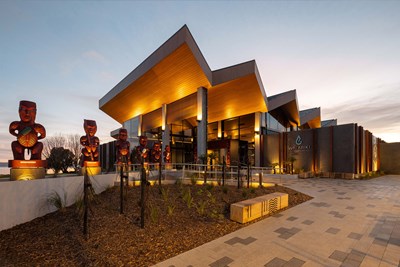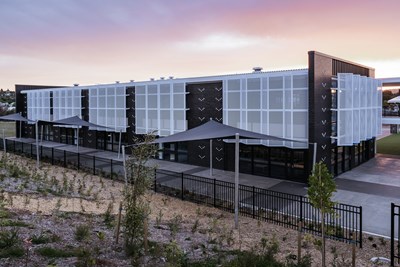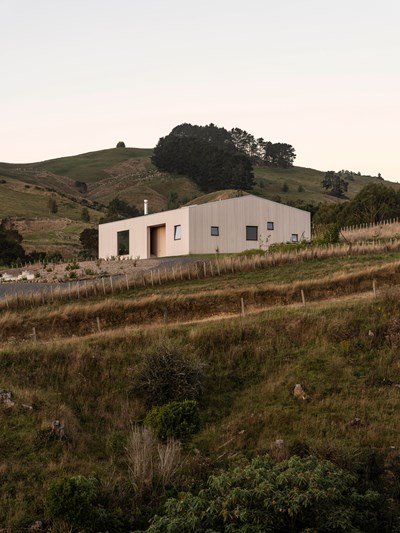From highly conceptual projects that redefine architecture to traditional high-end homes, the winners of this year’s best architecture in the Waikato and Bay of Plenty run the gamut of design.
The 29 winners include a groundbreaking building inspired by the journey of Te Arawa that houses counselling services, an illuminated translucent holiday home, and a tiny home for hobbits.
Jury convenor, architect Matt Grant says that the judges were impressed by the presence of te ao Māori in projects in many categories. Hamilton Kirikiriroa Airport, Te Rito O Manaaki Ora, Wai Ariki and Te Kura o Manunui are amongst the winning projects that have been imbued with a deep sense of Māori culture and design.
“From simple fit-outs to major commercial work, it's clear that in our region, iwi consultation is taken very seriously and Māori-influenced architecture is thriving,” says Grant. “These forms are incredibly innovative and the potential for them to inform resilient, affordable construction is massive.”
The use of colour to transform the experience of being in a building is another theme found in a handful of this year’s winners. Six projects will receive Resene Colour Awards. “Colour is being taken seriously by architects as a method of affecting an environment; from rich, bright and vibrant colours, to cool, relaxing and calming hues,” says Grant.
Unconventional projects make an appearance too. Summerhill Pavilions ’21 and ’22, a winner in the Small Project Architecture category, pushes the definition of architecture to its limit, with wall-less, latticework timber shelters inspired by ancient Japanese and Māori craftsmanship. The Chodge, a holiday home that is shaped like a woolshed and is constructed from illuminated fibreglass so as to be seen from afar, reinvents the idea of a rural dwelling. And the Hobbit homes nestled by Tilt Architecture into a hillside at Hobbiton, are similarly unconventional, and awarded in the Commercial Architecture category for their ability to transport visitors to Middle Earth.
Convenor architect Matt Grant was joined on the jury by Malcolm Taylor of Malcolm Taylor and Associates, Carl de Leeuw of WSP Architecture, Colette McCartney of GHD Design, and lay juror Anna Wilkinson from Area Design, Hamilton.
View all the winners and read citations here.
Commercial Architecture
Te Rito O Manaaki Ora by DCA Architects of Transformation
Bricks and Mortar by Edwards White Architects
MADE by Edwards White Architects
Wai Ariki by RCG and Pukeroa Oruawhata Lakefront Holdings in association
Hobbiton Bagshot Row by Tilt Architecture
Ibex Lighting by Wingate Architects
Education
The Pā by Architectus, Jasmax and Design Tribe
Te Kura o Manunui by ASC Architects
Tauranga Boys’ College — New Teaching Block by Designgroup Stapleton Elliott
Housing
Whareroa by Bossley Architects
Matua Masterclass by Brendon Gordon Architects
French Pass House by Christopher Beer Architect
The Chodge by DCA Architects of Transformation
Coromandel House by Evelyn McNamara Architecture
Lake Taupō House by RTA Studio
Grace by Stevens Lawson Architects
House on a hill by Stufkens + Chambers Architects
Stud Farm Residence by Sumich Chaplin Architects
Housing—Alterations & Additions
He Iti Ake by Architecture Bureau
Housing—Multi Unit
Hills Residences by Edwards White Architects
Interior Architecture
Hamilton Kirikiriroa Airport by AWA Architects
Baker Tilly Staples Rodway Fitout by Chow:Hill Architects
Public Architecture
Puna Kaukau o Te Oko Horoi — Perry Aquatic Centre by Architecture HDT
Te Kete Aronui Rototuna Library by Chow:Hill Architects
Hamilton Gardens, Ancient Egyptian Garden by Peddle Thorp Architects
Small Project Architecture
Summerhill Pavilions ‘21 & ‘22 by Andrew Barrie Lab
Whare Mīmīrū by Dr Anthony Hoete and Dr Jeremy Treadwell in association
The Garden Room by Edwards White Architects
Enduring Architecture
Cranwell Place (1970) by Noel D’Arcy Blackburn
































